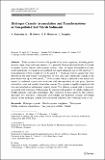Hydrogen Cyanide Accumulation and Transformations in Non-polluted Salt Marsh Sediments
Author(s)
Kamyshny, A.; Farquhar, J.; Mansaray, Z. F.; Oduro, Harry D.
Download10498_2012_Article_9180.pdf (510.3Kb)
PUBLISHER_POLICY
Publisher Policy
Article is made available in accordance with the publisher's policy and may be subject to US copyright law. Please refer to the publisher's site for terms of use.
Terms of use
Metadata
Show full item recordAbstract
While cyanide is known to be produced by many organisms, including plants, bacteria, algae, fungi and some animals, it is generally thought that high levels of cyanide in aquatic systems require anthropogenic sources. Here, we report accumulation of relatively high levels of cyanide in non-polluted salt marsh sediments (up to 230 μmol kg[superscript −1]). Concentrations of free cyanide up to 1.92 μmol L[superscript −1], which are toxic to aquatic life, were detected in the pore-waters. Concentration of total (free and complexed) cyanide in the pore-waters was up to 6.94 μmol L[superscript −1]. Free cyanide, which is released to the marsh sediments, is attributed to processes associated with decomposition of cord grass, Spartina alterniflora, roots and possibly from other sources. This cyanide is rapidly complexed with iron and adsorbed on sedimentary organic matter. The ultimate cyanide sink is, however, associated with formation of thiocyanate by reaction with products of sulfide oxidation by Fe(III) minerals, especially polysulfides. The formation of thiocyanate by this pathway detoxifies two poisonous compounds, polysulfides and hydrogen cyanide, preventing release of free hydrogen cyanide from salt marsh sediments into overlying water or air.
Date issued
2012-10Department
Massachusetts Institute of Technology. Department of Earth, Atmospheric, and Planetary SciencesJournal
Aquatic Geochemistry
Publisher
Springer Netherlands
Citation
Kamyshny, A., H. Oduro, Z. F. Mansaray, and J. Farquhar. “Hydrogen Cyanide Accumulation and Transformations in Non-Polluted Salt Marsh Sediments.” Aquat Geochem 19, no. 2 (October 13, 2012): 97–113.
Version: Author's final manuscript
ISSN
1380-6165
1573-1421